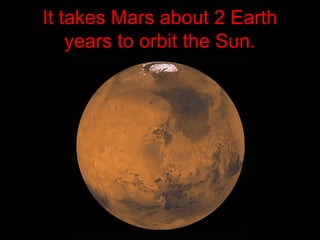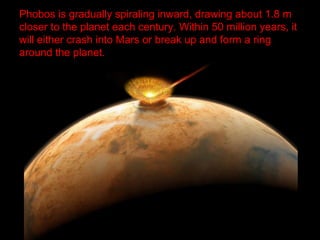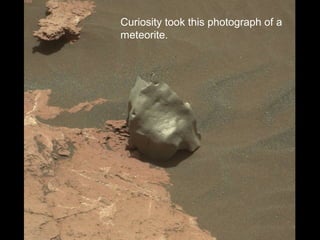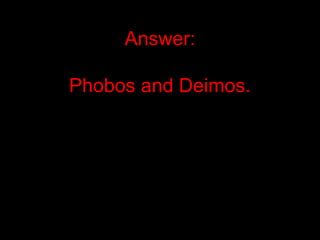Mars
- 1. The Inner Planets Part 3 Mars (5th grade) March 2017
- 2. The inner planets include Mercury, Venus, Earth, and Mars. Mars’s axis tilt is similar to Earth’s.
- 3. Mars is the 4th planet from the sun...
- 4. ...and the last of the terrestrial planets.
- 5. Photo of Mars’s surface taken by Pathfinder rover in 1997.
- 7. Mars has less mass than Earth, so it has less gravity, too. If you weigh 100 lbs. on Earth, you would only weigh about 38 lbs. on Mars.
- 8. https://youtu.be/z8aBZZnv6y8 Watch this 2:41 video on the planets’ orbits around the sun. Keep in mind that the scale is not accurate. The real scale is so large, it would be difficult to see each planet. Pay attention to Earth and Mars. Which orbits the Sun the fastest?
- 9. Question: Which orbits the Sun faster...Earth or Mars?
- 10. It takes Mars about 2 Earth years to orbit the Sun.
- 11. A Martian day is close to an Earth day. It is 24 hours 39 minutes long. A sunset on Mars.
- 12. How Did Mars Get Its Name? It’s red, as though from blood shed in battle. So, the Romans named it for their god of war, Mars. The Greeks called him “Ares”. It was known to the Babylonians 3,600 years ago as the “Star that Wandered”. Mars
- 13. Mars’s nickname is “The Red Planet”.
- 14. Mars is red because the dust on Mars is composed mostly of rusted iron. Oxygen chemically reacts with iron, creating rust.
- 15. The Martian sky is reddish in color because of its dusty atmosphere...
- 16. Light is made of a spectrum of colored wavelengths. You can see this spectrum when you look at a rainbow...
- 17. The rust dust that’s in the Martian atmosphere absorbs the blue light and scatters the red light, giving the sky a rusty color.
- 18. Interestingly, while sunsets on Earth are red, sunsets on Mars are blue. Earth sunset Mars sunset
- 19. What is the atmosphere on Mars like?
- 20. Mars has a thin atmosphere. It is only 1% as thick as Earth’s. Mars Earth
- 21. Mars’s atmosphere is composed mostly of carbon dioxide.
- 22. There is no rain on Mars because the low temperatures and pressures mean water can only exist as vapor or ice, although it may have have rained in the geologic past say scientists. This photo shows water ice that formed in a trench where a rover had scooped out a soil sample.
- 23. Mars has a lot of dust storms. Watch the following 3:24 min. video about Martian dust storms. https://youtu.be/SA1_bzS8-AI
- 24. Are there any clouds on Mars now?
- 25. Clouds on Mars are sometimes localized and can sometimes cover entire regions, but have not yet been observed to cover the entire planet. ... The clouds consist of water ice condensed on reddish dust particles suspended in the atmosphere.
- 26. NASA researchers have determined that Mars’s once rich atmosphere was stripped away by solar winds in the early days of the Solar System, causing the planet to dry out.
- 27. This shows how Earth’s magnetic field protects our own planet from solar wind. Without a magnetic field, solar wind would cause our atmosphere’s gas atoms to be blasted into space.
- 28. The liquid iron in our planet’s outer core is constantly flowing and moving. This movement generates an electric current, creating our planet’s magnetic fields. outer core
- 29. Mars lost its powerful magnetic field when it cooled too quickly, stopping it from having molten iron in its core. Now, the magnetic field Mars has left is simple and small.
- 30. NASA researchers believe that around 4.3 billion years ago, Mars had incredibly deep oceans that held more water than the Arctic Ocean here on Earth. Mars’s ocean may have looked like this.
- 31. Is Mars hot or cold?
- 32. Mars is a cold planet. Because its atmosphere is so thin, it doesn’t have a "thermal blanket” to retain any heat energy.
- 33. In winter, near the poles temperatures can get down to minus 195 degrees F. Notice Mars’s polar ice caps.
- 34. Mercury and Venus don’t have any moons. Does Mars?
- 35. Mars has 2 moons!
- 36. They were most likely meteors that were captured by Mars’s gravity.
- 37. This illustrates Phobos’s and Deimos’s orbits around Mars.
- 38. Both moons are small.
- 39. The moons were discovered by Asaph Hall in 1877. He named them after the mythological sons of Mars.
- 40. Phobos means “fear” or “panic”. Phobos has a 6 mile wide crater. Phobos whips around Mars 3 times a day.
- 41. Phobos is gradually spiraling inward, drawing about 1.8 m closer to the planet each century. Within 50 million years, it will either crash into Mars or break up and form a ring around the planet.
- 42. Deimos means flight (as in running away after an overwhelming defeat). Deimos orbits Mars once every 30 Earth hours.
- 43. Mars has the largest volcano in the solar system. It is called “Olympus Mons”.
- 44. Olympus Mons
- 45. The tallest mountains on Mars, Earth, and Venus compared. Mars Venus Earth
- 46. Mars also has the largest canyon in the Solar System. The canyon was named “Valles Marineris”. It is up to 4 miles deep and is 2,500 miles long! It is 125 miles wide at its widest point.
- 47. This shows the Mars canyon compared to the size of the United States. Watch the 3:44 min. video on this canyon. https://youtu.be/crsqzZNUXsY
- 48. How many craters does Mars have?
- 49. Mars has more than 635,000 impact craters that are each at least a ½ mile wide. In this image, each red dot represents one such crater.
- 54. There have been many missions to Mars and we Earthlings will continue to explore Mars now and in the future. Click on the link below to view the missions to Mars. The link may need to be cut and pasted into the browser. https://en.wikipedia.org/wiki/List_of_missions_to_Mars
- 55. Watch how the rover called “Spirit” landed on Mars on January 4, 2004. https://youtu.be/6t3IARmIdOI
- 56. In August of 2012, the rover “Curiosity” landed on Mars in a slightly different way. Watch this video to see how. https://youtu.be/gwinFP8_qIM
- 57. Now watch the real video footage, taken by the probe that carried Curiosity to Mars. https://youtu.be/gZX5GRPnd4U
- 58. https://youtu.be/nQ365jzwk5w Watch this 3:11 min. video on the rover called “Curiosity”.
- 59. Curiosity took this photograph of a meteorite.
- 60. Curiosity looks back at its tread marks.
- 63. Okay, it’s time to quiz yourself: How many moons does Mars have?
- 64. Answer: 2 moons
- 65. What are the names of these moons?
- 67. Question: Why is Mars red?
- 68. Answer: It has a layer of rusted iron dust.
- 69. Question: What are 2 things on Mars that are the largest in the solar system?
- 70. Answer: Mars has the largest volcano (Olympus Mons) and the largest canyon (Valles Marineris).
- 71. Question: What is Mars’s location in the solar system?
- 72. Answer: It is the 4th planet from the Sun.
- 73. Question: What is Mars’s atmosphere like, and what is it made of?
- 74. Answer: It has a thin atmosphere of carbon dioxide.
- 75. Question: What is the temperature like on Mars?
- 76. Answer: Mars is much colder than Earth.
- 77. Question: What is the gravity like on Mars?
- 78. Answer: Mars has less mass than Earth, so its gravity is less, too. If you weigh 100 lbs. on Earth, you’d only weigh about 38 lbs. on Mars.
- 79. Question: About how long is a year on Mars?
- 80. Answer: A Mars year is about 2 Earth years.
- 81. Question: How long is a Mars day?
- 82. Answer: A Mars day is 24 Earth hours and 39 minutes.
- 83. The End This PowerPoint was created by Mrs. Burch
Editor's Notes
- #2: image: https://i.ytimg.com/vi/z8aBZZnv6y8/maxresdefault.jpg
- #3: image: http://www.astronoo.com/images/planetes/axial-tilt-planets.jpg
- #4: http://www.planetsforkids.org/images/planets_image.jpg
- #5: image: http://www.mapsworldwide.com/itm_img/terreplantpostcd.jpg
- #6: image: https://mars.jpl.nasa.gov/MPF/ops/pan_segment3.gif info: https://en.wikipedia.org/wiki/Mars_Pathfinder
- #8: image: http://media-channel.nationalgeographic.com/media/uploads/photos/content/video/2016/10/04/778945603828_Mars_BigThinker_Mars101.mov.00_01_00_21.Still001.jpg
- #10: Answer: Mercury rotates very slowly. Answer: Venus rotates opposite the other planets.
- #11: image: https://www.jpl.nasa.gov/images/mars/20160421/PIA00407-16.jpg
- #12: image: http://tinypic.com/view.php?pic=35l70hz&s=6#.WNWbPRi-JXg
- #13: image: https://www.goddessgift.net/gods-heroes-images/mars-US-WU76021A4%2002.jpg
- #14: image: http://i.dailymail.co.uk/i/pix/2016/04/20/13/335C980C00000578-3549536-image-a-30_1461154094832.jpg
- #15: info: https://www.spaceanswers.com/solar-system/why-is-mars-red/
- #16: info and image: https://www.spaceanswers.com/solar-system/why-is-mars-red/
- #17: info: http://www.nbcnews.com/id/3077395/ns/technology_and_science-science/t/what-makes-skies-blue-or-red/#.WNslzhi-IxE image: https://aos.iacpublishinglabs.com/question/aq/700px-394px/many-colors-rainbow_95ac9f0a06552732-01.jpg?domain=cx.aos.ask.com
- #18: image: http://2.bp.blogspot.com/-qHgZFb5TOeY/T007AzCDx7I/AAAAAAAAAFM/MJCtx62jJ3s/s1600/mars_landscape.jpg
- #19: image: https://i.ytimg.com/vi/DwD3HD6t5Vs/maxresdefault.jpg image: http://weknowyourdreams.com/image.php?pic=/images/sunset/sunset-01.jpg
- #20: image: https://svs.gsfc.nasa.gov/11372
- #21: info: https://svs.gsfc.nasa.gov/11372 image: http://www.sciencealert.com/images/articles/processed/MarsFuturePast_web_1024.jpg
- #22: image: https://gotopac.files.wordpress.com/2013/04/carbon-dioxide-molecule.jpg image: http://www.sigmaaldrich.com/content/dam/sigma-aldrich/structure2/153/mfcd00011491.eps/_jcr_content/renditions/mfcd00011491-medium.png
- #23: info: https://www.washingtonpost.com/blogs/capital-weather-gang/post/the-nasa-curiosity-rover-and-weather-on-mars/2012/08/06/a1303d4c-dfdc-11e1-a19c-fcfa365396c8_blog.html?utm_term=.c4340b1b20ab image: http://www.findingdulcinea.com/docroot/dulcinea/fd_images/news/science/July-August/Examining-the-Meaning-of-the-Mars-Water-Discovery/news/0/image.jpg
- #26: info: https://www.google.com/search?q=are+there+clouds+on+mars&safe=strict&source=lnms&sa=X&ved=0ahUKEwi4weOr6oDTAhUL9mMKHc-pDlwQ_AUIBSgA&biw=988&bih=738&dpr=1 image: http://prancer.physics.louisville.edu/astrowiki/index.php/Mars
- #27: info: http://www.sciencealert.com/live-updates-nasa-is-announcing-what-happened-to-mars-atmosphere-right-now image: https://www.nasa.gov/sites/default/files/thumbnails/image/15-217-master.png
- #28: image: http://sci.esa.int/science-e-media/img/c5/solarwind-interaction-magnetosphere.jpg info: http://www.physics.org/article-questions.asp?id=64
- #29: image: https://blogs-images.forbes.com/trevornace/files/2016/01/layers-of-earth-1200x900.jpg?width=960
- #30: info: http://explanet.info/images/Ch06/06_04.jpg
- #31: info: http://www.sciencealert.com/live-updates-nasa-is-announcing-what-happened-to-mars-atmosphere-right-now image: https://www.nasa.gov/sites/default/files/thumbnails/image/15-032.jpg
- #32: image: http://cdn7.se.smcloud.net/t/photos/235739/mars_planeta_czerwona.jpg
- #33: image: http://inhabitat.com/incredible-video-of-mars-stitched-together-by-hand-from-33000-images/nasa-mars-image-2
- #34: info: http://www.space.com/16907-what-is-the-temperature-of-mars.html image: http://www.windows2universe.org/mars/places/mars_hubble_both_poles_big.jpg
- #35: image: https://img.clipartfest.com/4be7dda6e1a1ad2e073eaf6b8c280f9c_person-thinking-clip-art-clipart-of-a-person-thinking_1148-1149.jpeg
- #36: image: https://userscontent2.emaze.com/images/98b54264-a491-4cfe-8c40-84ff6211fa89/5c6fd5f2a081238cb0252c577eafce43.jpeg
- #37: image: https://www.thesun.co.uk/wp-content/uploads/2016/11/nintchdbpict000042941654.jpg?w=960&strip=all
- #38: image: http://www.observing.skyhound.com/shallow_sky/mars_moons.jpg
- #39: image: https://mars.nasa.gov/files/mep/facts/Moons-Mars-Facts.jpg
- #40: info: https://mars.nasa.gov/files/mep/facts/Moons-Mars-Facts.jpg image: http://www.outerplaces.com/media/k2/items/cache/f43211f9cb1c1956439021cc022c0a81_L.jpg
- #41: info. and image: http://solarsystem.nasa.gov/galleries/phobos-in-color
- #42: image: http://discovermagazine.com/~/media/Images/Issues/2014/June/mars-impact.jpg
- #43: info and image: http://solarsystem.nasa.gov/planets/mars/moons
- #45: image: http://annesastronomynews.com/wp-content/uploads/2012/02/Olympus-Mons-on-Mars.jpg
- #46: image: https://martianchronicles.wordpress.com/2009/05/23/olympus-mons-is-how-tall/
- #47: image and info: https://www.nasa.gov/multimedia/imagegallery/image_feature_83.html
- #48: image: http://webodysseum.com/wp-content/uploads/2012/10/Valles-Marineris-grand-canyon-mars-04.jpg
- #49: image: http://www.esa.int/var/esa/storage/images/esa_multimedia/images/2012/07/melas_dorsa_impact_crater_perspective_view/11630031-2-eng-GB/Melas_Dorsa_impact_crater_perspective_view_large.jpg
- #50: image and info: more than 635,000 impact craters at least 0.6 miles (1 kilometer) wide on Mars. In this image, each red dot represents one such crater.
- #51: image: http://i.dailymail.co.uk/i/pix/2012/06/08/article-2156466-13833E2D000005DC-562_634x462.jpg
- #52: image: http://www.dailygalaxy.com/.a/6a00d8341bf7f753ef0147e30fdb0a970b-pi
- #53: image: http://4.bp.blogspot.com/-A8mi3yLwrFI/UBp6Kh3j8NI/AAAAAAAAHYY/Ml736D4D38w/s1600/Sigli+and+Shambe+perspective+view.jpg
- #54: image: http://www.planet.geo.fu-berlin.de/eng/projects/mars/preleases/566/fullres/567-20120808-10572-co-HadleyCrater.jpg
- #60: image: http://www.slate.com/content/dam/slate/blogs/bad_astronomy/2017/01/15/curiosity_meteorite_sol1577.jpg.CROP.original-original.jpg
- #61: image: http://thehigherlearning.com/wp-content/uploads/2015/04/curiosity-water.png
- #62: image: http://images.huffingtonpost.com/2017-02-06-1486413381-4215230-rokymars.jpg
- #63: https://upload.wikimedia.org/wikipedia/en/8/8d/Rocky_Mars_Surface.jpeg


















































































